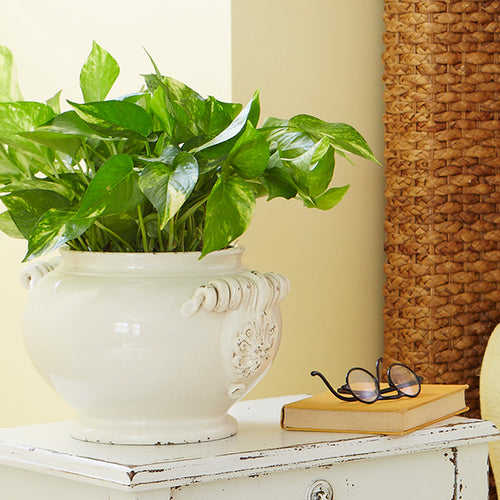By Doug Jimerson
Get your spring garden in shape with these must-do March tips.

Plant Annual Flowers in March Gardens
By the end March, gardeners in frost-free regions can begin planting warm-season annuals such as angelonia, wax begonia, and zinnia. Northern gardeners can start setting out cool-season favorites such as pansy, osteospermum, and alyssum.
Tip: Keep a light blanket or grow cloth handy just in case the temperatures drop unexpectedly. Cover your plants at night if it drops below freezing.
Discover beautiful cool-season annuals that take light frost.
Plant Trees and Shrubs in March
Early spring, when the weather is cool and moist, is a great time to add trees and shrubs to your landscape. Dig a hole slightly wider than the root ball of your plant. Then set the plant into the soil at the same height it was growing in its nursery pot. Water thoroughly and mulch.
Tip: Find out how large a tree or shrub will grow before you add it to your landscape. You don’t want to plant something that will eventually tower over your home.
Plant Berries in March Gardens
Strawberries and raspberries prefer an early spring start in your garden. Both can be grown in garden beds or containers. They require well-drained soil and a sunny spot that receives at least 6 to 8 hours of sunshine a day.
Tip: Strawberries and raspberries are available in Everbearing and June-bearing varieties. Everbearers produce small amounts of fruit all summer long while June-bearers develop one large crop in early summer. Plant both types to gain the maximum amount of fruit over a longer period of time.
Start Veggies from Seed
In the North, lettuce, spinach, radishes, peas, and other cool season crops can be sown directly in the garden in March. In frost-free regions, plant warm weather vegetables such as tomatoes and squash. Cover the plants if an unexpected cold snap threatens.
Tip: Sow radishes, spinach, beans, and peas in wide rows instead of single file. You’ll get more produce per square inch if you scatter seed in a 6 to 10 inch wide band.
Repot Houseplants
March is a perfect time to give indoor plants a new lease on life by transplanting them into a larger pot with fresh soil. This is especially important if your plants are root bound (you’ll see roots coming out of the pot’s drainage holes). Also, if the roots are growing in a tight ball, loosen them to encourage new growth.
Tip: March is also a good time to prune houseplants that might have grown leggy over the winter. Pruning will also encourage new, more compact growth.
Check out our gallery of popular, easy-to-grow houseplants!
Dig and Divide Perennials in March Gardens
Perennials such as hosta, chrysanthemum, and daylily can be dug and divided as soon as they break dormancy. Use a sharp spade to dig and lift the clumps and break them into smaller sections with a large garden knife. Replant the divisions as soon as possible.
Tip: Some perennials prefer being divided in the late summer instead of early spring. These include peony, lily, Oriental poppy, and bearded iris.
- Get step-by-step tips for dividing perennials.
- Looking for perennials? Check out this list of long-blooming varieties.
- Discover 14 easy-to-grow, sun-loving perennials.
Feed Camellias and Azaleas
Fertilize camellias and azaleas after they finish flowering. Use a commercial camellia/azalea granular fertilizer sprinkled around the base of the plants. Be sure to read the label for application rates. Feed monthly through August for best growth and flowering.
Tip: In the fall and winter, use a 0-10-10 fertilizer to help build next spring’s flower production. That mixture of nitrogen, phosphate, and potassium will also increase your plants’ ability to tolerate cold weather.
Check Irrigation
Water is a precious resource. That’s why, if you have an irrigation system, it’s important to check it now. Look for broken heads or inefficient spray patterns that can waste water. Also, adjust your timer so you aren’t watering your yard during the rainy season.
Tip: Most lawns and gardens require an inch of moisture a week. If you are unsure of how much water you are providing, set a coffee can in the yard and measure what it catches.
Spray and Prune Fruit Trees
There’s still plenty of time to prune apples and other fruit trees. Remove dead, diseased or crossed branches before the trees break dormancy. Also, eliminate vertical branches to allow sunlight to penetrate the interior of the tree. Fruit is only produced on horizontal branches so don’t worry about minimizing your harvest. Tip: Spray your trees before they leaf out with a dormant oil spray. It’s an effective method of reducing insect pests organically. Follow label directions when you apply dormant oil spray.
Clear Flower Beds
Rake leaves and mulch away from garden beds to allow the foliage of spring-flowering bulbs and perennials to poke through. During the winter, leaves can pack down, forming an impenetrable barrier to new growth. Plus when you pull back the mulch, the soil will warm faster because it’s exposed to the sun.
Tip: Use a plastic leaf rake when you remove mulch. Metal garden rakes with sharp tongs can rip tender foliage from emerging plants.
March Gardening Questions?
We love to talk to other gardeners. Email us your questions and we'll have one of our experts get back to you!
Written by Justin Hancock

















